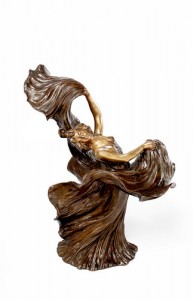Carousel of Misbehavior in the Folk Art World
In the seamy underbelly of folk-art collecting, owners over the past century have muddied the attributions of works, brazenly added new flourishes to old woodcarvings, and let bird droppings and paint spatters gather on canvases in storage.

A sculpture from about 1900 of the performer Loïe Fuller is part of a show of Art Nouveau items at Macklowe Gallery.
The historian Elizabeth Stillinger has named culprits in “A Kind of Archeology: Collecting American Folk Art, 1876-1976” (University of Massachusetts Press). She researched the book for about 15 years, poring through museum and family archives. Reporting on owners’ misdeeds was possible because “most of them are dead,” she said dryly in a recent phone interview from her home in Westport, Conn. “You hope that you won’t offend their descendants too much.”
The painter Fred Dana Marsh and his wife, Mabel Van Alstyne Marsh, “took liberties with carousel horses that would flabbergast a present-day collector,” she writes in “A Kind of Archeology.” The Marshes, who had homes in Maine, Florida and upstate New York, carved wooden tails and manes to replace lost horsehair fringe, and added glass jewels to reins and saddles.
When the couple gave the animals to the Smithsonian Institution in the 1960s, curators discovered the misguided, drastic alterations. As a consequence most of the Marsh collection “has been in storage for many years,” Ms. Stillinger writes.
In the 1940s Col. Edgar Garbisch and his wife, Bernice Chrysler Garbisch, practically bought a painting a day. But they kept little data about provenances and artists. “There is no evidence that they were concerned about serious research or careful documentation,” Ms. Stillinger writes. The collection ended up scattered as museum gifts, leaving scholars to puzzle over the Garbisches’ sources.
Ms. Stillinger also covers museum administrators behaving badly. In the 1970s the American Folk Art Museum was so poorly managed that it had to pay off debts by selling most of its permanent collection for $22,000. Officials had depended on financing from Burt Martinson, a coffee company scion who was a museum founder, but he died in 1970.
This year the Folk Art Museum fell into debt again, and its collection narrowly escaped dispersal. Donations had been flowing from the jewelry merchant Ralph Esmerian, who is serving prison time for financial fraud. “A Kind of Archeology” shows portraits of girls in red dresses and a copper angel weathervane that he gave to the museum in better days.
BOSOM-HEAVING SCULPTURE
A show rather heavy on erotica opens Wednesday at the Macklowe Gallery in Manhattan.
In “Dynamic Beauty: Sculpture of Art Nouveau Paris,” female bronze nudes wear ecstatic expressions while flirting with Poseidon and entangling their legs around sea foam, drapery, flowers and octopus arms.
The statues and vessels (with prices into the six figures) are often dismissed as kitsch. Producing a 272-page scholarly catalog with artist biographies “is like exploring an unexplored world,” said Benjamin Macklowe, an owner of the gallery.
A catalog essay by the exhibition curator, Jessica Goldring, theorizes that the carnally aggressive figures symbolized newfound freedoms for Parisian women around 1900. On a gilt bronze vase, Ms. Goldring writes, “a lesbian liaison is established between the women through the interwoven strands of their tresses and their smiling faces.”
Mr. Macklowe has brought out a few dozen objects representing the actresses Sarah Bernhardt and Loïe Fuller, twirling skirts and veils and exulting over dying male lovers. The femmes fatales dictated how they would be portrayed in bronze. “They were businesswomen and took control of their lives,” he said.
CIVIL WAR SOUVENIRS
In the sesquicentennial commemorations of the Civil War regional exhibitions so far have covered topics as narrow as battlefield doctors from Albany, and Kentucky families divided by sympathies for the North and South. Troops from the New York region are only now receiving their share of museum attention.
“Gone for a Soldier: Jerseymen in the Civil War” opens Sunday at the Macculloch Hall Historical Museum in Morristown, N.J. The 200 pieces, borrowed mainly from historical societies and private collectors, range from 1861 collapsible steel cutlery for early recruits to an 1865 lithograph of a widow weeping at an infantryman’s grave.
By: Eve M. Khan
Source: www.nytimes.com
